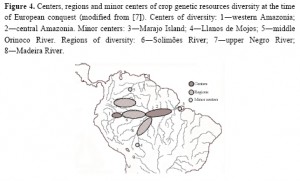- 4000 year old lentil sprouts.
- It looks bad for cassava in SE Asia.
- Bill Gates speaks out on sustainability and productivity.
- “Gardeners must unite to save Britain’s wildlife.” We say: what about Britain’s landraces?
What percentage Neolithic are you?
A big new human genetics paper in PLOS has been making a big splash. It tries to distinguish between two extreme possibilities about the people of Europe:
- Europeans are descended from Middle Eastern farmers, who brought their Neolithic cultural toolkit less than 10,000 years ago.
- Europeans are descended from Paleolithic hunter-gatherers, who acculturated to the farming way of life through diffusion of ideas.
The title gives it away: “A Predominantly Neolithic Origin for European Paternal Lineages.” Based on one key Y-chromosome haplotype, it goes for the first option, which is a similar result to studies using mtDNA, although other studies do not agree quite so much. Those old hunter-gatherers — or their genetic traces at any rate — are only to be found in Finland now. The rest of us Europeans can trace our origin to a greater or lesser extent back to the first farmers, those who built Çatalhöyük, for example. Until, that is, the next big new human genetics paper.
Nibbles: School gardens, Nabhan, Reforestation, Swine flu, Boar, Nutrinomics, Medieval sheep, Market, Acacia, Livestock breeds, Bees, Buffalo breeding, Quinoa
- Resource list for setting up a school garden. Take that, Flanagan.
- Gary “Eco-gastronaut” Nabhan goes viral.
- Smithsonian goes native. Trees, that is.
- GRAIN video delves into origin of H1N1.
- There are boar farms of England?
- Nutrition advice needs to take genetics into account.
- Tracing the changing morphology of British post-medieval sheep. Well, someone has to do it.
- Thai floating market. A tourist trap, I know. But photogenic.
- Kew’s plant of the day is gum arabic. Wait, Kew has a plant of the day? Is there no end to their ingenuity?
- And GlobalDiv has a Breed of the Month. BTW, the same source has a thing on the XVIII Plant and Animal Genome Conference (Jan. 2010).
- Diverse diet for healthier bees, says BBC
- Breeding bovines in Asia.
- Cursed quinoa.
Amazonian agriculture analyzed
I don’t know about you, but in my laziness I sometimes catch myself making the assumption that a centre of crop origin is also one of crop diversity. That is of course sometimes the case, but by no means always, as Vavilov himself recognized. A recent open access paper in Diversity makes the point very clearly. 1
The authors, led by Charles R. Clement of the Instituto Nacional de Pesquisas da Amazônia in Manaus, review molecular studies and also bring in archaeological and other evidence in their discussion of the history of Amazonian crops. They come to the conclusion that these crops originated around the periphery of the region: “All but one of the species examined originated in the periphery of Amazonia (Figure 3), rather than along the major white water rivers where pre-conquest population densities were greatest.” Here’s that Fig. 3:
Now, in contrast, here’s where the pre-Columbian hotspots of diversity were to be found: “The major centers and regions of diversity are along the major white water rivers and in northwestern Amazonia, where ethnic diversity is extremely high.”
The explanation, according to the authors, is the length of time involved in the development of agriculture in the region.
Because crop domestication began thousands of years before food production systems became important, it is not at all surprising to see a dramatic contrast such as that in Amazonia.
Why was the Amazonian periphery such a focus of domestication?
It is possible that sufficient natural resources were available [in central Amazonia] so that the home gardens were such a small fraction of subsistence that they are difficult to find in the archaeological record. In contrast, in the headwaters of the same rivers in the periphery, less abundant aquatic resources may have increased the importance of home gardens.
Nibbles: Breeding, Vegetables, Early agriculture, Breeding course, Nabhan, Gardens, Sequencing twice, er no, once.
- Solanum porno.
- Veggie tourism.
- Something else to blame climate change for. Not.
- Wanna learn breeding?
- Gary does Turkey.
- Podcast on school gardens.
- Department of improbable claims: Sunflower genome holds the promise of sustainable agriculture.
- Ok then Mr Cynical, how about woodland strawberry, then?
- Not so fast, Mr Sunshine: No strawberry genome ::sniff::

